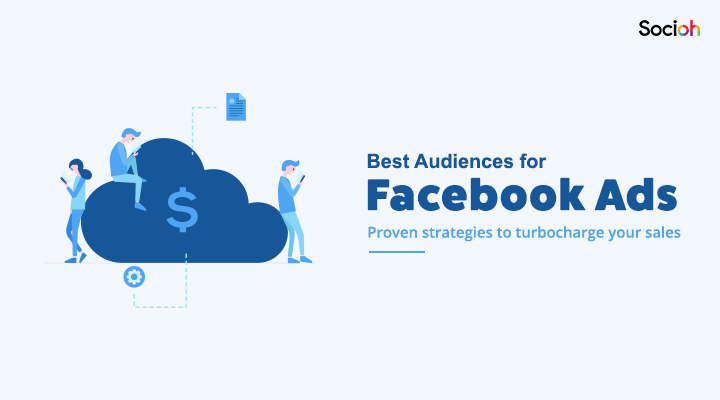
Are you an eCommerce brand running Facebook marketing campaigns? Here’s how to choose the best target audiences for Facebook and Instagram ads.
First, what are Facebook audiences? Why are they important?
Simply put, Facebook audiences include all users on Facebook (and Instagram) who may see your ads. You can make this selection as wide or as specific as you like.

When you set up an ad or a campaign, Facebook’s targeted advertising lets you enter ‘signals’ to select specific users.
These signals help the platform’s algorithms ensure that your ads are shown only to the most relevant potential buyers, which reduces your ad spend. For example, if you’re a Manhattan-based bakery specializing in children’s birthday cakes, your most relevant target audience would include mothers of young children within about 30 miles of your store.
With Facebook audiences, you can ensure that your ads are shown to just this target demographic, and you don’t waste your ad dollars on singles in San Francisco, or couples with children away at grad school.
Further, Facebook can help you track ‘qualified’ audiences, or users who don’t need much convincing to make a purchase. These could include past purchasers, users who’ve looked at Disney-themed cakes on your website but haven’t yet ordered a cake, moms who follow the pages of another cake shop or a party-supplies stores in your neighborhood, etc.
Used right, this translates into more purchases from your ads—and you spend less acquiring each customer. More savings, hurray!

What are the different kinds of Facebook audiences, and how do you create Facebook audiences?
For a business manager, Facebook has several audience tools. You can create ads based on Demographic Targeting, Custom Audiences and Lookalike Audiences, or a combination of these. Here’s a brief overview of the three:
1. Demographic Targeting: Choose population groups based on their location and other demographics such as age, gender, marital status, household income, etc. You can also use Facebook’s detailed behavioral targeting—using users’ interests and preferences, pages they like, device usage, etc.
2. Custom Audiences: Custom audiences comprise users who have already engaged with your brand and may be created in several ways:
- Custom audience from a list are especially useful if you have lots of offline order data. Customer data you’ve collected outside of Facebook can be manually uploaded to Facebook, and used to create audiences.
- Engagement custom audiences consist of users who have engaged with your brand on Facebook (liked or commented on your posts, opened a lead form, signed up for events, etc.).
- Website custom audiences are also based on engagement, but specifically, engagement on your website, tracked with the help of Facebook ‘Pixel’. Read about what a Pixel is, and why your store should have one. Facebook lets you use this data to run various kinds of ‘retargeting’ ads to convert users already familiar with your brand.
3. Lookalike Audiences: You can use Facebook’s algorithms to target audiences that look like your custom audiences. For example, when you create a lookalike of your past purchasers, Facebook’s AI will look for cold or new users who share the traits of people who have purchased from you in the past.
Tip: Facebook recommends that your source audience contain at least 100 people from a single country. However, to give Facebook a big enough sample, we recommend/suggest that your lookalikes should be based on at least 500 users—the larger your seed audience, the more precisely Facebook will be able to target your lookalike audience.

How many different kinds of audience(s) can I set up?
The simple answer to that? Endless.
Depending on how you choose to segment and layer your data, you can have hundreds of audiences for your Facebook and Instagram ads. Before you let that scare you though, here’s what you need to know. If you’re an eCommerce brand advertising on Facebook, your ads have one of two main objectives:
1. Using your data from your Facebook Pixel for retargeting users who have visited your website. These users are already familiar with your brand and include past purchasers, people who’ve viewed products, signed up for your newsletter, added items to their cart, etc. Retargeting ads are a great way to help you sell more by showing users creatives and deals on products they’ve already shown interest in.

2. Prospecting to expand your customer base and bring new or cold audiences to your online store. Prospecting ads that use effective lookalike audiences and behavioral targeting are good ways to narrow cold audiences to keep your ad costs low.

Find the best audiences for Retargeting Ads on Facebook
For retargeting ads, you need to segment your Pixel and order data to achieve better Return on Advertising Spend (ROAS). Typically, your Facebook Pixel will capture user engagement data, including page and category views, ‘events’ such as add to cart, checkout, and any other custom events you may have set up.
The Pixel will store (for up to 6 months) user data that can be used to create different kinds of audiences for your campaigns. Based on this, you can get an idea of your audience funnel.

In the example above, your Facebook ad brings a hundred people to your site. Your Pixel records that 70 users have viewed your content, of which 15 users ‘Add to Cart’, and roughly 4 of them make a purchase. How do you use this data to create great audiences?
Here are some quick and easy tips for selecting audiences for retargeting:
1. Segment by on-site behavior: You’re setting up ads, you’re getting people in your Pixel, and you’ve got a fair amount of data. Now what? How do you optimize this data to improve your ROAS?
The answer lies in intelligent segmentation. Once you get a big enough sample, narrow it down based on on-site behavior—category viewers, past purchasers, high spenders, cart abandoners, repeat buyers, or any other specific audiences whom you think will convert well for your brand.

Pro Tip: If you’re thinking of running a retargeting campaign on Facebook, we recommend that there be at least 500 users in your Pixel. Read more about when to get started with Facebook ads.
2. Customize your campaigns for different segments: To set up a healthy retargeting funnel, don’t ignore any segment, not even early bouncers (those who left your website without viewing any products).
Instead, customize your ad creative and copy for different segments. Read our detailed piece on the best ads for every step of your buyers’ journey, for a step-by-step breakdown of the best campaigns for different user segments.
3. Don’t restrict yourself to Pixel data: Do you have a significant amount of order data offline? Don’t ignore it! Upload it using Facebook’s ‘Custom audience from a list‘ option to complement your Pixel data and target a wider selection of qualified users.
4. Pay attention to exclusions: Exclude overlapping or irrelevant segments from your ad’s audience. For instance, if you use your Pixel data to target all users with ‘Add to Cart’ events, remember to exclude purchasers who’ve checked out their cart.
Not only does this help you avoid annoying existing customers, it also helps you save precious $$!
How to select the best audiences for Cold Ads:
If you’re prospecting new audiences, here’s how you can target a wider set of users without blowing your budget:
1. Have a clear buyer persona for behavioral targeting: Determine who your ideal buyer is, and develop one or more detailed buyer persona(s). Be as specific as possible with gender, age-range, location, and other demographic markers.
For example, if your brand sells organic skincare, are you going to target only women over 30, or include ranges for men and teens? What should be their household incomes? Do your target audiences also buy from other brands like Whole Foods or Lululemon? Would you consider Juice Beauty or True Botanicals your competitors? Once you have this clarity, you can choose from Facebook’s range of interests and demographics to run your cold ads.
For instance, you can run a catalog of your anti-ageing products to women between 30–60 years of age, whose household income is in the top 10%. You could also target audiences based on interests—organic food (general) or specific brands like “Lululemon” or “Juice Beauty”.


2. Create effective lookalike audiences: Use past data to create lookalikes to reduce prospecting costs. Mine all your data to create lookalikes of top spenders, 1%, 5% and 10% lookalikes of past purchasers, or even events like ‘Add to cart’.
You can also sort your customers by category, to create specific campaigns based on their interests.
For example, if your organic hair care line brings you the best profits or highest average order value, create a lookalike of all these category buyers to target users who are likely to buy your bestsellers or new arrivals in that range.
Similarly, if your store sells both apparel and jewelry, create lookalikes for jewelry purchasers only for your new arrivals to get more relevant audiences.

3. Refine and layer: Instead of restricting yourself to basic segmentation, further refine your audiences by adding details like location, device use, etc.
For example, if your highest value orders all come from 10 zip codes, you can target niche products from your highest range to past purchasers from these zip codes. Choose a powerful creative with a message that stresses how exclusive your products are (such as “Made in America with handpicked ingredients”) to get a super-targeted campaign.
You can also layer lookalike audiences with behavioral targeting to narrow down your ad-segments further. For example, run a 10% lookalike of all past purchasers, layered with an interest like organic food or yoga to target highly relevant audiences.

Don’t forget to test creatives and copy as you refine your audiences and test which segments work best for your brand. Ensure that your ads speak to your audience, and over time, you’ll find patterns that’ll help you maximise your return on ad spend.

Still not sure where to start? Use Socioh’s intelligent segmentation for eCommerce to create audiences easily (and get recommendations on the best audiences for your brand). Sign up now!
Socioh is a digital advertising platform for eCommerce brands. Our Branded Catalog is the industry leader in dynamic catalog advertising and product feeds.




